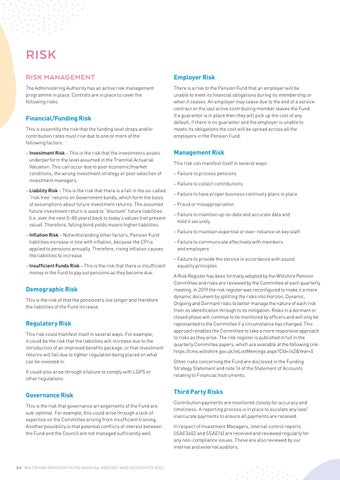RISK RISK MANAGEMENT
Employer Risk
The Administering Authority has an active risk management programme in place. Controls are in place to cover the following risks.
There is a risk to the Pension Fund that an employer will be unable to meet its financial obligations during its membership or when it ceases. An employer may cease due to the end of a service contract or the last active contributing member leaves the Fund. If a guarantor is in place then they will pick up the cost of any default, if there is no guarantor and the employer is unable to meets its obligations the cost will be spread across all the employers in the Pension Fund.
Financial/Funding Risk This is essentilly the risk that the funding level drops and/or contribution rates must rise due to one or more of the following factors: – Investment Risk – This is the risk that the investments assets underperform the level assumed in the Triennial Actuarial Valuation. This can occur due to poor economic/market conditions, the wrong investment strategy or poor selection of investment managers. – Liability Risk – This is the risk that there is a fall in the so-called “risk free” returns on Government bonds, which form the basis of assumptions about future investment returns. The assumed future investment return is used to “discount” future liabilities (i.e. over the next 0–80 years) back to today’s values (net present value). Therefore, falling bond yields means higher liabilities. – Inflation Risk – Notwithstanding other factors, Pension Fund liabilities increase in line with inflation, because the CPI is applied to pensions annually. Therefore, rising inflation causes the liabilities to increase. – Insufficient Funds Risk – This is the risk that there is insufficient money in the Fund to pay out pensions as they become due.
Demographic Risk This is the risk of that the pensioners live longer and therefore the liabilities of the Fund increase.
Regulatory Risk This risk could manifest itself in several ways. For example, it could be the risk that the liabilities will increase due to the introduction of an improved benefits package, or that investment returns will fall due to tighter regulation being placed on what can be invested in. It could also arise through a failure to comply with LGPS or other regulations.
Governance Risk This is the risk that governance arrangements of the Fund are sub-optimal. For example, this could arise through a lack of expertise on the Committee arising from insufficient training. Another possibility is that potential conflicts of interest between the Fund and the Council are not managed sufficiently well.
54 WILTSHIRE PENSION FUND ANNUAL REPORT AND ACCOUNTS 2021
Management Risk This risk can manifest itself in several ways: –F ailure to process pensions –F ailure to collect contributions –F ailure to have proper business continuity plans in place –F raud or misappropriation –F ailure to maintain up-to-date and accurate data and hold it securely –F ailure to maintain expertise or over-reliance on key staff –F ailure to communicate effectively with members and employers –F ailure to provide the service in accordance with sound equality principles A Risk Register has been formally adopted by the Wiltshire Pension Committee and risks are reviewed by the Committee at each quarterly meeting. In 2019 the risk register was reconfigured to make it a more dynamic document by splitting the risks into Horizon, Dynamic, Ongoing and Dormant risks to better manage the nature of each risk from its identification through to its mitigation. Risks in a dormant or closed phase will continue to be monitored by officers and will only be represented to the Committee if a circumstance has changed. This approach enables the Committee to take a more responsive approach to risks as they arise. The risk register is published in full in the quarterly Committee papers, which are available at the following link: https://cms.wiltshire.gov.uk/ieListMeetings.aspx?CId=142&Year=0 Other risks concerning the Fund are disclosed in the Funding Strategy Statement and note 16 of the Statement of Accounts relating to Financial Instruments.
Third Party Risks Contribution payments are monitored closely for accuracy and timeliness. A reporting process is in place to escalate any late/ inaccurate payments to ensure all payments are received. In respect of Investment Managers, internal control reports (ISAE3402 and SSAE16) are received and reviewed regularly for any non-compliance issues. These are also reviewed by our internal and external auditors.


